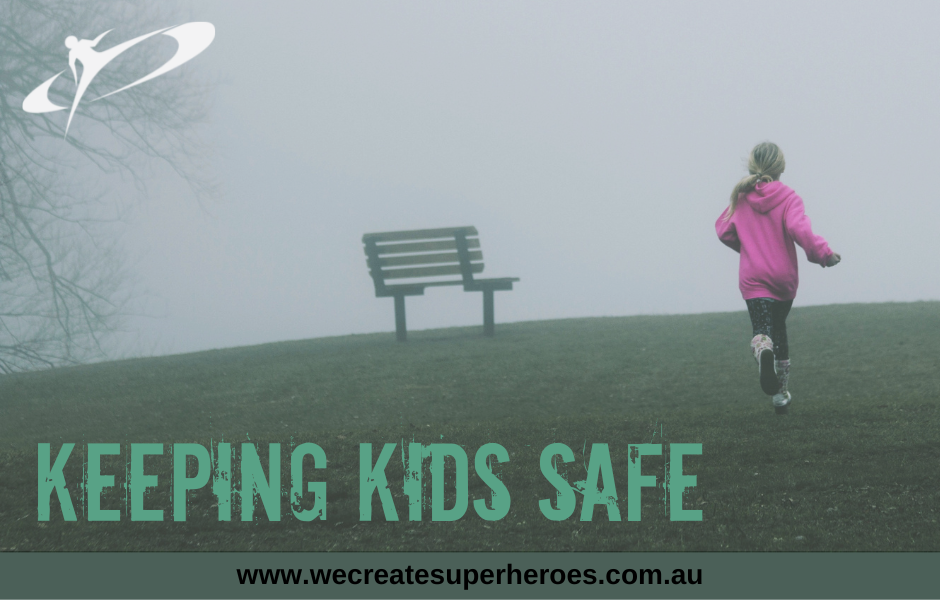Keeping our kids safe is something parents have a tendency to have on their minds constantly – an awareness with no off switch. In real and practical terms though, we try to avoid thinking about it at all. Maybe this is because unless child abductions and abuse cases happen close to home, thoughts of the possibility of harm coming to our kids are too confronting.
Awareness is Key
In Safety Net, our self defence program for children, we teach the necessary skills in self-protection that are a fundamental part of child safety education. However, we go beyond teaching physical defences. In order to help protect themselves against an adult, children need to recognise when an adult is not a safe person. In a critical moment of choosing their response, it may be very difficult for a child to take the safest action. As adults, we have more experience in assessing an interaction and in being guided by intuition. Children may feel torn between maintaining their learned respectfulness of adults, and trusting their intuition and self defence lessons. This touches on the first important message we want to share about safety: Awareness is the key.
Caution rather than fear
Developing awareness in kids about their own personal safety, while building their self defence skills, without making them hypervigilant and fearful is a line that we all need to tread carefully. Kids are naturally inclined towards believing in fairness, kindness and caring, and they generally believe this will be reciprocated. We have seen evidence of this in research where children, even when informed and equipped with all the stranger danger messages we can impart on them, will still tend to trust and go with an unknown adult who tells them they have a hurt or lost puppy and they need the child’s help.
Thankfully, this is a rare occurrence. People are mostly good, and we need to teach kids not to fear every adult. In fact, the research shows most dangers lie with people children already know. But we don’t want to teach them to fear trusted adults either.
Creating time and distance beats overpowering an adult
Secondary to awareness is defence. In our Super Safety self defence unit for children, we start with stranger awareness, and help the children develop competency with a simple grab escape. While it may not always be a stranger who is the danger, it is important to teach them the escape in order that they learn the fundamental principles of awareness, and creating time and distance.
The reality is, most children do not have the strength to overpower an adult. And to keep themselves safe, they don’t always need to. They need to give themselves time and distance, and this is also what we teach in our defences.
“talking about the lessons at home is an opportunity to open a conversation with your children”
In order for these lessons to be effective, they must be repeated. Children need a lot of practice for defences to become internalised, and we strongly recommend that children practise at home with parents. This applies to both practising the defensive skills until they become automatic, and reinforcing messages of awareness of personal safety. But more than this, talking about the lessons at home is an opportunity to open a conversation with your children and to show them that while there may be lots of things in the world that are unsafe, there is nothing that is unsafe for them to talk to you about.
This helps develop a relationship of trust between children and parents such that they will feel safer disclosing to you about anything that worries them, even when it may be a secret they have been warned or threatened to keep. Sometimes this may not even be their own secret. Children often feel safer disclosing things to a friend. That friend may be your child, who may then speak to you with the trust that you will be able to deal with a secret they feel burdened with.
“supportive and open communication within families, so that as our children grow up, they do not close up”
This is not just about the safety of children, but of teens. It is about establishing and fostering a habit of good, supportive and open communication within families, so that as our children grow up, they do not close up. We often hear that teens don’t talk to their parents, and that parents don’t know how to talk to their non-communicative teens. In fact, counsellors tell us that teens do talk – about their parents, fears, peer pressures, relationships, bullying, school stressors, and concerns and worries about the future. And more often than not, they want to talk. It’s never too early to start showing them how.
